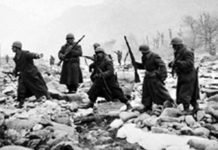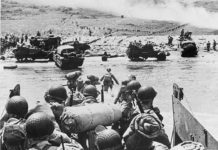During the Indian Wars, a tragedy suffered by the US Army would spawn the birth of heroic legend for John “Portegee” Phillips on the Wyoming frontier.
Disaster Leads to a Call for a Hero
When one conjures up their idea of a western hero, the name “Portegee” Phillips is not likely to come to mind. However, John Phillips holds his place in history as a verified hero nonetheless. John, a Portuguese emigrant turned miner and frontiersman, played a large part in saving a besieged frontier army outpost from possible annihilation. On December 21, 1866, eighty men under the command of Captain William Fetterman were surrounded and killed by an estimated force of over 1000 Sioux warriors in what would known as the Fetterman Massacre.
Fetterman had been garrisoned at nearby Ft Phil Kearny, one of three posts along the Bozeman Trail in present-day Wyoming. The forts were tasked with protecting travelers bound for the newly discovered gold fields to the northwest from hostile Sioux and Cheyenne warriors intent on ridding their hunting grounds of all white intruders.
Following the Fetterman debacle, Ft Phil Kearny was threatened to be overrun by the hostile Indians as it now had only 119 soldiers and civilian employees to hold the outpost and protect the numerous women and children inside. The post commander, Colonel Henry Carrington of the 18th Infantry, faced a difficult decision. His first option was to send a large column of men to Ft Laramie for help 235 miles away. While the column would be capable of protecting itself against an Indian attack, the absent men would further weaken the garrison at Ft Phil Kearny and increase the risk of it being overrun.
Carrington’s second option was to send a lone courier with dispatches requesting reinforcements to the nearest telegraph office at Horseshoe Station and hope the message got through. The commander decided on the later. John Phillips volunteered for the dangerous mission to go get help. The dispatch penned by Carrington read in part: “I venture as much as anyone can, but I have had a fight today unexampled in Indian warfare… Depend on it that this post will be held as long as a round or a man is left. Promptness is the vital thing. Give me officers and men. Only the new Spencer arms should be sent…”
The Historic Ride of John Phillips
Portegee Phillips, employed as a civilian working for the fort quartermaster, was to carry the message 190 miles south to Horseshoe Station. His provisions were sparse. Clad in a buffalo coat, hat, boots, and gauntlets, he armed himself with a Spencer rifle and 100 rounds of ammunition. His cartridges were fastened around his ankles. Their weight would help keep his feet in the stirrups. Colonel Carrington gave him one his best horses, a strapping black thoroughbred named “Dandy” who was known for his speed. Provisions consisted of a few hard biscuits and a small bag of feed for his mount.
At midnight, he left the fort alone in a blizzard with temperatures bottomed at 25 degrees below zero. Traveling only at night and distantly parallel to the Bozeman Trail through three to five feet of snow, Phillips somehow managed to slip through Indian sentries intent on intercepting and killing him. He arrived at tiny Ft Reno on December 23 having traveled almost 60 miles. The fort’s commander, Lt. Col. Henry Wessells, drafted another message for Phillips to carry on to Ft Laramie after delivering his dispatches to Horseshoe Station.
Portegee arrived at the station on the morning of December 25. Carrington’s dispatch was wired to Washington and the Department of the Platte in Omaha informing his superiors of the Fetterman Massacre and the dire circumstances at Ft Phil Kearny.
The night before, Portegee had been stalked by a sizeable war party of Indians. Seeking refuge on a hilltop, Phillips fended off his pursuers all night and “made a run for it” to the station at dawn. He then rode on to Ft Laramie with Wessells’ message of the disaster. Arriving almost froze to death just before midnight in the midst of a Christmas ball, Phillips delivered the news to Laramie’s commander, Colonel Innis Palmer. Phillips’ horse lay dying from exhaustion and exposure in the parade ground with the thermometer still hovering at 25 below zero.
Reinforcements were delayed in leaving Ft Laramie until January 6, 1867 due to deep snow. John Phillips rode with them having been given the choicest mount from Company F of the 2nd Cavalry. The column finally arrived to relieve Ft Phil Kearny on January 16. The original version of the story indicated that Phillips made the entire 235 mile ride alone. However, it is now clear that he had other men accompany him along parts of the journey including when he rode into the telegraph office at Horseshoe Station.
From Hero to a Growing Legend
For his services, the humble John Phillips was paid 300 dollars. That April, while carrying mail from Ft Phil Kearny to Ft Laramie, he again managed to escape from an attacking war party of 15 Sioux. After the close call, Phillips told his superiors that “without aid of my faithful horse, and good revolver, I would have lost my hair, the part of my body I feel most anxious about on the prairies.”
John died in Cheyenne, Wyoming on November 18, 1883. Although the government was slow to recognize Portegee Phillips for his heroic deeds, in part because his status as a US citizen had been in question, it ended up granting his widow 5000 dollars for his services to the Army 32 years after his historic ride. A fitting tribute to his legend would continue to live on in one of his children. The boy was given the name Paul Revere Phillips.








